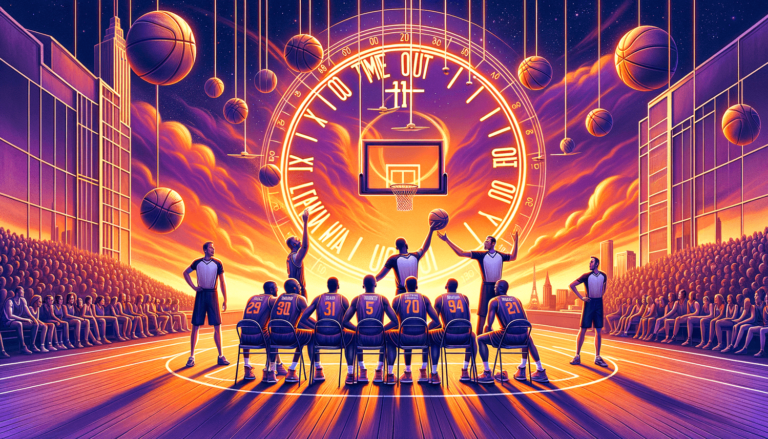
Time Out Rule in Basketball: How Many and When
Written by: Basketball Universe
Last updated:

Are you eager to unravel the mysteries of the time out rule in basketball? You’re in the right place, hoops enthusiast! 🏀 In this fun and professional blog post, we’ll dive deep into the world of time outs, exploring their significance, when coaches can deploy them, and how many they can call during a game. So, tighten your sneakers and ready yourself for a slam-jamming exploration of the ins and outs of the time out rule in basketball! 🏀
Time Out Rule in Basketball: How Many and When
In basketball, time outs are opportunities for teams to regroup, strategize, and catch their breath. Each team is allowed a set number of time outs depending on the level of play and league rules. In the NBA, teams receive 6 full time outs per game, with an additional 2 allocated for each overtime period. In the NCAA, teams are granted 5 time outs, including 3 full and 2 thirty-second time outs. Coaches can call time outs during dead ball situations, after a made basket, after a free throw, or by requesting through players on the floor. Understanding the strategic use of time outs and their limitations is crucial for effectively navigating the demanding world of basketball competition.
Bouncing Through the Basics of Time Outs
Before we slam dunk into the nitty-gritty details, let’s first understand what a time out in basketball is. In essence, it is a brief pause in the game, during which coaches can discuss strategies, give pep talks, or adjust their team’s dynamic. Now that we have our footing, let’s take a closer look at time out rules concerning the number and when to call them, across various basketball organizations.
Navigating the NBA Time Out Rules
In the National Basketball Association (NBA), coaches and players must be familiar with their time out allocation to effectively manage the game. As the rules may vary slightly, understanding the NBA’s time out structure is crucial for success.
The Six-Time Out Rule
Under NBA regulations, each team is granted six full time outs per game. However, for games broadcasted nationally, the league may reduce the total number of full time outs to seven per team. Key takeaway? Always remember that you have six full time outs at your disposal in a standard NBA game.
Managing Time Outs Across Quarters
There is more to NBA time out rules than simply knowing the total number per game. The league has a cap on time outs per half and mandatory time outs as the clock ticks down:
- Each team can use up to four time outs in the second half (two in the first quarter and up to three in the second).
- Each team is limited to two time outs in the last three minutes of the fourth quarter.
- NBA authorized media time outs, colloquially known as mandatory time outs, occur after the first dead ball following the 6- and 3-minute marks of each quarter. Teams are only charged with a time out if they call one before the mandatory time outs.
Always keep an eye on the game’s pace and the number of remaining time outs. Effective time out management often means the difference between victory and defeat.
Mastering the NCAA Time Out Rules
College basketball has its unique regulations, particularly when it comes to time outs. The NCAA time out rules are slightly different from the NBA’s, and understanding these nuances is vital for college coaches and players.
Three Full Time Outs and Two 30-Second Time Outs
In NCAA basketball, each team is granted five total time outs – three full time outs and two 30-second time outs. Full time outs last for 75 seconds, while 30-second time outs are, unsurprisingly, 30 seconds in duration. As a coach, knowing the difference between full and 30-second time outs can greatly impact the outcome of the match.
Mandatory Time Outs and Carry Over
In NCAA basketball, there are also mandatory time outs, officially known as media time outs. They occur at the first dead ball under the 16-, 12-, 8-, and 4-minute marks of each half. If a team calls a time out before media time outs, it becomes the media time out, and the team is only charged for a 30-second time out.
An additional adjustment in NCAA play is that unused 30-second time outs carry over to the second half but not to overtime periods. Be mindful of your remaining time outs during the first half, as managing them effectively can pay dividends in the game’s outcome.
Exploring FIBA Time Out Rules
The International Basketball Federation (FIBA) governs competitions outside the NBA and NCAA. Understanding its time out regulations is crucial for players and coaches participating in international play, such as the Olympics or the Basketball World Cup.
Two Time Outs in First Half, Three in Second Half
The FIBA time out rules differ from both the NBA and NCAA. Teams are granted two time outs in the first half and three time outs in the second half, with each time out lasting for one minute. One crucial aspect to remember is that FIBA rules do not allow teams to carry over unused time outs between halves, so use them strategically.
Calling a FIBA Time Out
In FIBA basketball, coaches can only call a time out through the officials during a dead ball situation or after a made basket by their own or opposing team. A time out cannot exceed 60 seconds, and after 50 seconds, a warning signal is given. Following the rules diligently will ensure smooth gameplay and prevent possible sanctions for rule violations.
Handling High School Basketball Time Out Rules
For high school basketball players looking to make a mark on the court, understanding time out regulations is essential. In the United States, the National Federation of State High School Associations (NFHS) governs high school basketball rules.
NFHS Time Out Allocation
The NFHS grants teams three full time outs and two 30-second time outs per game. Full time outs last for 60 seconds, while 30-second time outs, as the name suggests, last for 30 seconds. A firm grasp on your time out allowance will enable you to govern the game’s flow more effectively.
Carrying Over Unused Time Outs
Similar to the NCAA, unused 30-second time outs in NFHS basketball can be carried over from the first half to the second half but not to overtime periods. Monitor your remaining time outs closely, as they can be vital to your success on the court.
Buzzing through Basketball Rules: Know Your Time Outs and Score Big
Regardless of the level of play, understanding the nuances of time out rules in basketball is an essential ingredient for success. By grasping the rules for each respective league, coaches and players can make better decisions, control game tempo, and ultimately emerge victoriously. So, whether you’re participating in NBA, NCAA, FIBA, or high school basketball games, being knowledgeable about basketball rules, particularly time outs, can help elevate your performance on the court.
Overtime Time Outs and Beyond
When the game goes into overtime, the dynamics of time outs can shift, catching a team off guard. Savvy players and coaches are aware of the rules concerning time outs during overtime, preventing unwanted surprises during close games that could ultimately affect the outcome.
Overtime Time Outs in the NBA
When an NBA game goes into an extra period due to a tied score at the end of regulation, the number of time outs allocated to each team increases. During each overtime, both teams receive two additional full time outs, regardless of the number of time outs they used during regulation play. Staying abreast of this rule during nail-biting games can empower your team at a crucial moment.
Overtime Time Outs in the NCAA
As with the NBA, NCAA basketball teams receive additional time outs during overtime. Each squad gets one additional full time out (75 seconds) per overtime period, regardless of how many time outs they used in regulation. Unused time outs from regulation play also carry over to overtime, and 30-second time outs can accumulate up to four total.
Overtime Time Outs in FIBA and NFHS
Both FIBA and NFHS have established similar rules regarding time outs during overtime games. In FIBA play, each team gets one additional time out per overtime period, and any unused time outs from regulation play do not carry over. As for NFHS, the teams are granted one extra full time out (60 seconds) per overtime period, without any carryover of unused time outs from regulation.
Achieving Greatness with Strategic Time Out Management
Mastering basketball time out rules is only half the battle. To truly shine during gameplay and stay adaptable, arm yourself with a myriad of tried-and-true time out strategies. Time outs offer unique opportunities for coaches and players to communicate, reassess, and implement high-level tactics.
Breaking the Momentum
Calling a time out can be a potent weapon against a team that is gaining momentum. By strategically using a time out, you can interrupt your opponent’s rhythm, prevent scoring runs, and give your team an opportunity to regain its footing.
Rest and Recovery
Time outs provide players with crucial moments to rest and rehydrate, especially during high-intensity games. By knowing when to call a time out, coaches can ensure the well-being and performance of their players, ultimately maximizing on-court efforts.
Addressing Tactical Adjustments
One of the most effective functions of a time out is the ability to make immediate tactical adjustments. Whether you need to switch up defensive strategies or implement new plays, time outs offer a valuable platform for coaches and players to quickly adapt to in-game situations.
Preparing for Crucial Possessions
As the game clock winds down, last-minute shots and plays can determine the game’s outcome. By calling a time out, coaches can discuss strategy, calibrate the team’s approach, and prepare for pivotal in-game moments that could make or break the game.
Conclusion: Time Out Commanders Win the Court
Time outs in basketball are more than just a break in play; they’re an essential aspect of overall game strategy. By knowing the ins and outs of time out rules in various leagues and harnessing time outs to their fullest advantage, players and coaches can navigate the complexities of basketball with finesse, finding success on the hardwood. So, master the time out rule in basketball and lead your team to victory, one strategic pause at a time!
FAQ: Time Out Rules Demystified
For quick reference and ease of use, we’ve compiled an FAQ section addressing common questions associated with time outs in basketball. Browse through these frequently asked queries to further expand your knowledge and rule the court!
1. How long does a full time out last in the NBA?
A full time out in the NBA lasts for approximately 2 minutes and 45 seconds, which includes a stipulated 1 minute and 15 seconds for players and coaches to converse, along with additional time for commercial breaks.
2. Can a player call a time out during a game?
Yes, a player on the court can call a time out. However, the specific rules for requesting a time out vary across different leagues. Generally, a player can signal the referees for a time out during a dead-ball situation or following a successful basket, subject to league regulations.
3. Are there any penalties for calling too many time outs?
Yes, there can be penalties for calling an excessive number of time outs. Most leagues penalize a team for attempting to call a time out without having any remaining by issuing a technical foul, which awards the opposing team one free throw and possession of the basketball.
4. Can a team call a time out during an opponent’s free throw?
Yes, teams may call a time out before or in between an opponent’s free throws but not during the free throw itself. Coaches often utilize this strategy to potentially disrupt the concentration of the free throw shooter.
5. What happens if a team does not use all of their allocated time outs?
Unused time outs do not carry any direct consequences. However, in some leagues like the NCAA and the NFHS, unused 30-second time outs carry over to the second half or overtime. Remember: effectively managing your time out allowance could create a strategic advantage during gameplay.
6. Are there any additional time outs issued during the last two minutes of an NBA game?
No extra time outs are awarded during the last two minutes. However, teams are limited to using only two time outs during the final three minutes of the fourth quarter, irrespective of the total number of time outs remaining.
7. Can a coach call a time out during live play in FIBA basketball?
No, in FIBA basketball, coaches are only permitted to request a time out during a dead ball situation, following their own or opposing team’s successful basket. Players on the court must signal the referees for a time out request during live play, adhering to league regulations.
8. Do high school basketball time out rules differ between states?
In the United States, the National Federation of State High School Associations (NFHS) governs high school basketball rules, and these regulations remain mostly consistent across states. However, some states or conferences may implement minor modifications or additions to the NFHS rules.
9. Can a team call back-to-back time outs in basketball?
Yes, a team can call consecutive time outs, as long as they have remaining time outs in their allocation. However, using back-to-back time outs may not always be a strategic course of action, as this could exhaust the team’s time out resources too quickly.
10. Are there any changes to time out rules during international basketball tournaments?
Time out rules generally remain consistent during international basketball competitions, as they adhere to FIBA regulations. However, certain tournaments may implement minor adjustments or specific time out protocols, which participants should be aware of prior to the competition.
Featured Posts
- No pillar pages found.





